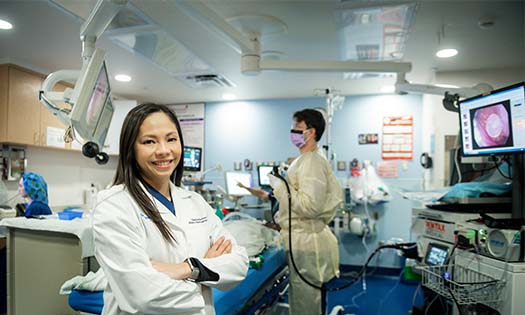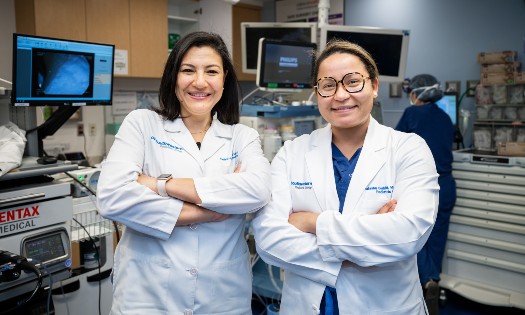Signs of biliary atresia (a blockage of bile ducts that causes bile buildup in the liver) usually emerge in the first weeks after birth. Every day that passes without a diagnosis raises the likelihood of liver damage requiring liver transplant.
Natasha Corbitt, M.D., Ph.D., Pediatric Surgeon at Children’s Medical Center Dallas, part of Children’s HealthSM, and Assistant Professor at UT Southwestern, is developing the FIInd Green in Stool test, which can cut down the diagnostic process to just 24 hours – and could one day help exclude the diagnosis of biliary atresia without a traditional cholangiogram in the operating room. Dr. Corbitt discusses details about the test and its potential to transform biliary atresia care.
What is the FIInd Green in Stool test?
It stands for Fluorescent Imaging of Indocyanine Green in Stool. We propose making it one of the first steps in diagnosing biliary atresia.
The test involves injecting indocyanine green into the bloodstream through an IV, then waiting for it to flow through the circulation, get picked up by the liver and flowing into the bile ducts and excreted as feces. If we don’t see green fluorescence in their stool, it means the bile ducts are blocked and we can expedite surgery for biliary atresia.
If we do see green, then our study – soon to be published by the Journal of Pediatric Surgery – showed FIInd Green in Stool was 95% accurate compared to traditional cholangiogram in determining whether the bile duct is open in cholestatic infants.
How does the test accelerate the path to diagnosis?
Currently it takes around a week to rule out biliary atresia in a cholestatic infant. This is done via numerous tests and eventually a cholangiogram, which is a surgical procedure performed under anesthesia.
With FIInd Green in Stool, you get vital info within 24 hours. If you don’t see fluorescence in the stool, you can jump right to surgical treatment for biliary atresia.
Will babies still need a cholangiogram after this test?
It depends. When babies don’t have green in their stool and require surgery, a cholangiogram is part of that process. It is done to evaluate the anatomy before performing surgery.
But if the baby does have green in their stool, you can save them a trip to the OR. This is important because we don’t want to sedate a baby and make incisions if we don’t have to. FIInd Green in Stool is safe, inexpensive and noninvasive. All you need is an IV and poopy diapers.
How does FIInd Green in Stool help pediatric surgeons perform cholangiograms?
If there is no green in the stool and you expedite cholangiogram and surgery, the presence of the fluorescent dye helps the surgeon work laparoscopically rather than doing an open procedure.
Most surgeons do not perform laparoscopic cholangiograms on infants, because the procedure can be very technically challenging. You inject contrast directly into the gallbladder and see if it flows back through the biliary tree – but that’s the opposite direction of normal bile flow, and sometimes the contrast doesn’t flow that way easily. In that case, you have to pinch the distal duct closed to create pressure that pushes the contrast backward. It’s not easy, so most surgeons opt for an open cholangiogram.
But if you’ve already tried FIInd Green in Stool, you don’t need to worry about that, because the fluorescent dye flows in the normal direction. It reaches the liver and stops, so the liver appears fluorescent while everything after it does not. The surgeon can readily see when ducts are obstructed without any tricky maneuvers or large incisions.
What have you learned about indocyanine green since first adapting it for babies?
Dosing for infants is much smaller than for older children
The dye is commonly used in older children for gallbladder surgery, in doses up to 5 milligrams. But we found that infants need just a tiny amount – 0.1 milligram per kilogram. Otherwise, the fluorescence is too overpowering to see the anatomy clearly.
24-hr window to look for stool
In older kids without cholestasis, the fluorescent dye reaches the bile ducts within 60 minutes. But for babies with reduced bile flow from cholestasis, we learned it takes more time. We allow 24 hours for the baby to pass it in their stool.
What’s next for the FIInd Green in Stool test?
We plan to explore how it might be used in combination with another test – measuring matrix metallopeptidase-7 (MMP-7) levels in the blood – to diagnose biliary atresia without needing a cholangiogram at all.
MMP-7 is a biomarker for scarring in fibrosis, which is strongly associated with biliary atresia. This discovery was spearheaded by Jorge Bezerra, M.D., Pediatric Hepatologist at Children’s Health and Professor and Chair at UT Southwestern. At most centers, you have to send out blood to test for MMP-7 levels which can take a week to result, but now we can do the test right here, so we get results rapidly.
If a combination of blood and stool tests can accurately identify which babies have biliary atresia, it will totally change our approach to this disease and help us deliver the right care for each child much more quickly.
Children’s Medical Center Dallas has a Level I Children’s Surgery Center designated by the American College of Surgeons, which recognizes its deep commitment to surgical excellence and innovation.
Learn more about innovative approaches to pediatric liver disease at Children’s Health >>


